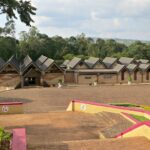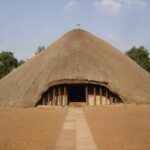Lake Katwe, located in Queen Elizabeth National Park west of the Uganda capital, is a captivating site known for its salt deposits. This article describes the lake’s unique features and highlights the cultural and economic significance of salt mining in the area. By paraphrasing the content and organizing it for readability, we aim to present the information in a more accessible format.
Formation of Crater Lakes in Uganda
Uganda’s crater lakes, including Lake Katwe, were formed through volcanic activity approximately 8,000 to 10,000 years ago. Volcanic eruptions led to the creation of these geographical features. When intense heat builds up beneath the Earth’s surface, the molten lava escapes through a vent, causing pressure to build. As the lava reaches the surface, the hollow space left behind collapses, forming a crater. Over time, these craters fill with water, becoming what we now call crater lakes.
Crater Lakes in Western Uganda
Most sunken lakes in Western Uganda, including Lake Katwe, were formed during similar volcanic periods. While most of these lakes are now dormant, a few still emit sulfurous gas, indicating the potential for future volcanic activity. Queen Elizabeth National Park has three major crater lakes, including Lake Katwe. The Bunyaruguru Crater Lakes and those in the Nandali Kasende area of Kibale Forest National Park are also worth exploring.
Lake Katwe stands out as one of the prominent crater lakes in Western Uganda and offers excellent opportunities for hiking and safaris for visitors to Queen Elizabeth National Park. Exploring the crater lakes in the park may also allow you to catch a glimpse of flamingos. During the wet season, the lake evaporates heavily, causing salt substances to concentrate and form solid salt rocks mined by local communities.
Salt Mining Process at Lake Katwe

In the dry season, the saline water of Lake Katwe undergoes evaporation, leading to the concentration of salt and the formation of salt crystals. Women collect the crusted salt from the lake’s surface, while men scoop salt blocks from the lake’s lower reaches. Salt production is at its peak from January to March and July to September, making these periods ideal for witnessing the salt production process.
Salt mining in Lake Katwe is a challenging and demanding activity requiring high enthusiasm and dedication. The water in the lake is toxic and emits a foul odor, affecting workers mentally and physically. To protect themselves, women place flour in their reproductive organs, while men wear condoms to prevent contact with the water. Miners endure long hours under the scorching sun and the unpleasant smell of the evaporating saline water. Additionally, the temperature drops significantly during the radiant season when salt production is low.
Visiting Lake Katwe Salt Works
Lake Katwe Salt Works welcomes visitors for day or half-day visits. Although local guides are limited, they can provide insights into the activities conducted on the lake. Supporting the local community’s economy is possible by purchasing specialty foods from local suppliers. These dishes are prepared with care and served by residents who set up tables for guests, offering a chance to experience the local culture while contributing to the salt mining industry.
Besides exploring the salt works, visitors can engage in other activities around Lake Katwe, such as cultural walks and windsurfing. These experiences add to the overall enjoyment of a safari in the area, offering ample opportunities for adventure and discovery.












